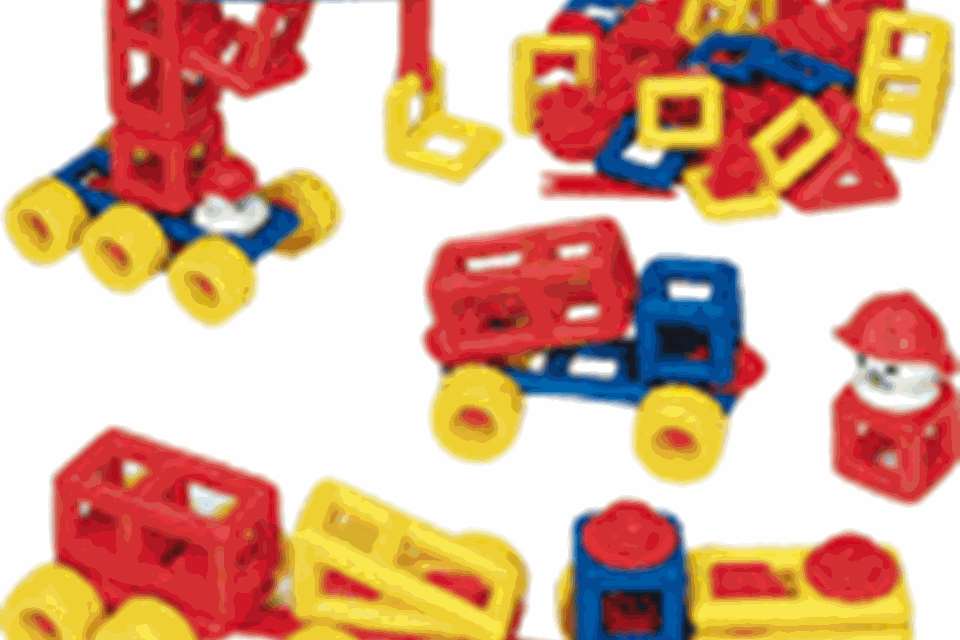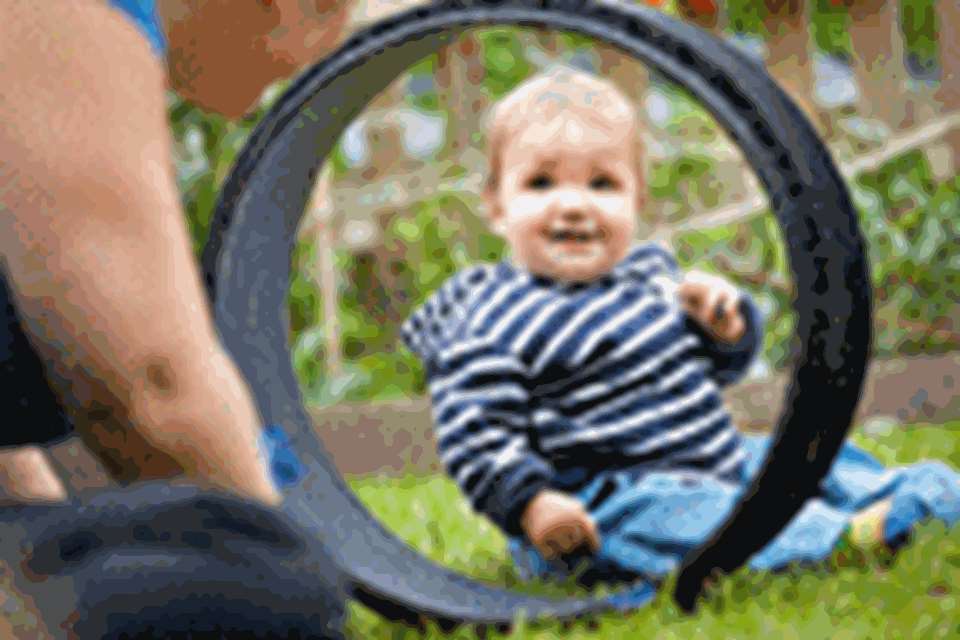EYFS Best Practice: All about… care routines
Penny Tassoni
Monday, March 5, 2018
Feeding, dressing and nappy changing support learning and development, explains Penny Tassoni
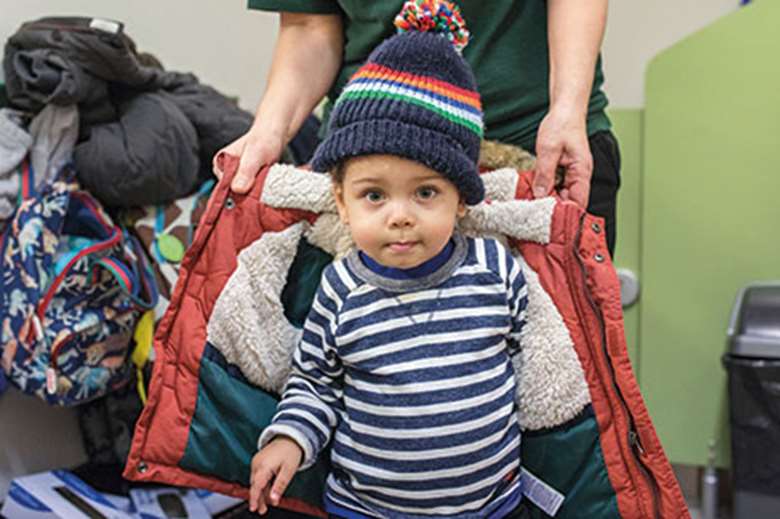
Download the PDF of All About...Care Routines
Nappy changing, feeding, dressing and sleeping all come under the umbrella term of ‘care routines’. These routines are not only necessary to children’s health, but they also have the potential to support babies’ and toddlers’ learning and overall development.
For most children under the age of three, at least two hours a day will be spent being fed, changed, encouraged to nap or being dressed. As such, one might imagine that volumes would be written about these care routines and that every early years setting would have a ‘care routine’ co-ordinator who could advise the team. Interestingly, this is rarely the case. This is perhaps because traditionally, care routines were seen only in the context of health. Today, though, there is a greater understanding that all aspects of our work with children, however routine they may be, can play an important role in children’s holistic development. The term ‘educare’ has been adopted by some settings to express this.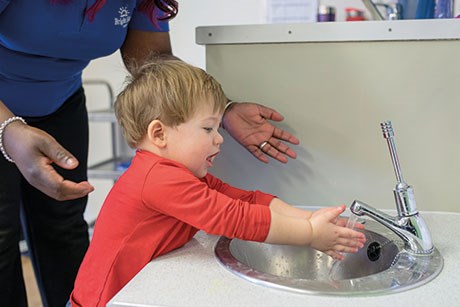
CARE ROUTINES AND IMPACT ON DEVELOPMENT
When looking at care routines in the context of holistic development, we can see how great practice can translate into significant developmental opportunities for babies and toddlers. For settings working with the EYFS, these translate into the Prime areas of learning.
Personal, Social and Emotional Development
Many care routines will support aspects of children’s personal, social and emotional development. In particular, it is worth focusing on how care routines in your setting promote a child’s self-efficacy and help children to build strong relationships with adults and each other.
Self-efficacy
The term ‘self-efficacy’ has been coined by Albert Bandura to describe a child’s or adult’s belief in their competency and, therefore, likely success in succeeding at a task or situation.
Self-efficacy is an important component in the development of self-esteem. It is thought that a sense of self-efficacy begins in early childhood and develops as a result of experiences and the reaction of others.
Care routines that allow babies and toddlers some level of choice, control and the opportunity to be participative will support feelings of competency. In practice, this means encouraging a toddler who wants to wipe their own face to do so or to let a baby take a spoon from you if they wish to have a go.
On the other hand, where babies and toddlers are not given any opportunities to take control or are constantly having their wishes overridden, there is a danger that they will develop lower levels of self-efficacy.
Making relationships
Care routines can deepen the bonds between key person and child. They often involve one-to-one moments and also touch. The element of touch is important for babies and toddlers. Gentle handling and hugs on the way can reduce children’s stress levels while also helping them to feel more secure.
While relationships with the key person are central to many care activities, children can also develop relationships with others during meal times. Although babies are likely to mainly focus on their key person, toddlers often make connections with others. They may watch and copy each other. It is not unusual for toddlers to bang beakers or cutlery down onto a table and then laugh.
Managing feelings and behaviour
The term ‘self-regulation’ is increasingly being used in relation to how children learn to manage their emotions and control their impulses. The development of self-regulation is thought to support children’s ability to persevere and defer gratification. Interestingly, care routines can help in the early development of self-regulation. It would appear routines and predictability are good starting points for young children.
During some care activities, babies and toddlers experience moments when they have to wait a little. Babies may have to wait until their bib is on before feeding starts or a toddler may have to wait for another child before reaching out for a piece of fruit. With the help of an adult who can support them by talking, singing or giving them something to hold, babies and toddlers learn that although they have to wait, their needs and desires will be met.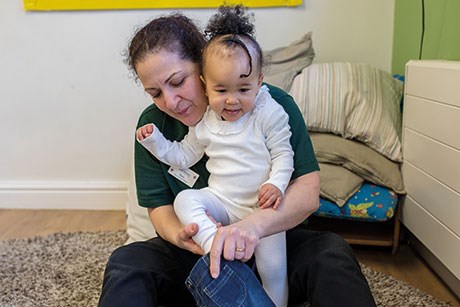
Communication and Language Development
Care routines offer opportunities for one-to-one interactions. These are precious moments as babies and toddlers need plenty of one-to-one interactions in order for them to develop language.
Some of the best opportunities for communication and language development occur during nappy changing. At other times, such as at meal times or dressing, the adult will need to be sensitive and follow the child’s pace and lead. This is because activities involving physical skills that are still being learnt often require such concentration that there is less capacity to talk during movement. Having said this, there will still be plenty of moments for interaction during pauses and also in the run-up and aftermath of the care routine.
Language routines
One of the ways in which babies and toddlers develop early language is through the use of language routines. Most practitioners and parents use language routines during care activities without even realising it. They may say ‘All gone now!’ when a baby has finished their bottle or ‘Let’s get you clean’ during a nappy change.
The same phrases being used at the same points in a care activity can help babies and toddlers to associate actions or objects with key words or sentences. Language routines also help babies and toddlers understand where they are within the sequence of the care activity.
Physical Development
Most care routines contain elements where, over time, babies and toddlers can practise physical skills that will eventually lead children to develop independence. This, as we have seen, is important in supporting emotional development.
Balance and gross motor development
Dressing and also meal times can support balance and gross motor development. Very early on, babies learn to push their arms through the sleeves in garments and also take off socks and hats. Mealtimes also offer toddlers opportunities to balance as they sit at a table. Interestingly, one of the signs that a toddler is becoming tired or frustrated is when they start to find it hard to sit.
Hand-eye co-ordination
Handwashing, dressing and feeding are care activities that have inbuilt opportunities for older babies and toddlers to develop hand-eye co-ordination. Interestingly, babies and toddlers are often well disposed to practise these skills as the sensory nature of water and the taste of food are great motivators.
As hand eye co-ordination is a developing skill, it is important that sufficient time and encouragement is given to children.
It can be painful to watch a baby or toddler repeatedly drop food off a spoon, but unless the baby or toddler is becoming frustrated, it is worth holding fire.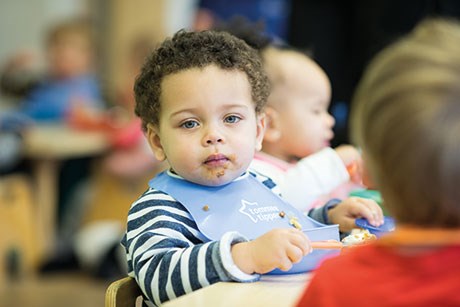
BEST PRACTICE
There are a few key elements that underpin great practice when it comes to care routines. These elements have to be in place in order to unlock the learning potential within each of the care activities.
Attitude
A good starting point when looking at care routines is to consider attitudes towards them within an early years setting. Are they seen as unwelcome interruptions to ‘more important’ parts of the session? Are they seen as messy, dirty or annoying activities that have to be dealt with quickly? Or are they seen as opportunities for a key person to build bonds with a child in a meaningful way and as opportunities to observe the incremental, yet exciting changes in a child’s development?
In some ways, attitudes towards care routines are influenced by the leadership in a setting. Leaders who recognise their importance and, in particular, understand how they impact children’s emotional development are more likely to support and develop practitioners’ practice.
Practitioners are more likely to put in time, effort and resources to ensure that each and every part of the care routine is an experience that is enjoyable both for the child but also the practitioner. While the health aspects of each care activity will remain central, there will be an understanding that care routines are developmentally important and that a child-centred approach is needed.
Planning process
Where leaders within a setting value care routines, practitioners are more likely to enjoy and celebrate each and every nappy change, meal time or the washing of hands. This celebration is evident in the interactions between adult and child, but can also be seen in the observation and planning process. Practitioners may think about ‘next steps’ not just in terms of play and activities, but also in terms of what happens during a care routine.
Conversely, a sign that care routines are not being celebrated is the presence of a rota. Rotas are management tools used often for undesirable tasks and when it does not matter who completes the tasks.
While many settings no longer have official rotas in place for care routines, it is important for any leader to check that a rota approach and accompanying attitude have not crept in, albeit informally.
Questions for reflection
How are care routines viewed by practitioners within your setting?
Are there any particular care activities that are seen as less positive than others?
What training and support is available to help practitioners understand the holistic benefits of care routines to children’s overall development?
Is sufficient time allowed for each of the care activities?
Do staff observe children’s interests and development during care activities?
Child-centred experiences
Alongside having a positive attitude towards care routines, early years settings that have good practice consider each care routine from the child’s point of view. This is important as care routines, some of which are inherently adult-led, can otherwise become something that adults do to children. The face that is wiped without warning and without seeing if the child can do it themselves, the snatch-and-grab approach to nappy changing or rushing to get a child dressed.
Interestingly, when the child’s experience is not given priority, we may see it in terms of babies’ and toddlers’ responses. Toddlers may vote with their feet and refuse to sit at a table; a crawling baby may wriggle and struggle during nappy time.
By focusing on the child’s experience, many elements fall into place. These include the participation of the child, thinking about the environment where the care routines take place, and taking into consideration the child’s preference as to who supports them during the care routine.
Questions for reflection
In your setting, is the equipment comfortable for children?
What can children see and hear during care routines?
Are staff aware that children’s skin and sense of touch are particularly sensitive?
Do staff understand how to physically handle children comfortably and in ways that respect their dignity?
Are children provided with time, equipment and encouragement to show some independence?
How many opportunities with each of the care activities are available for children to exercise some degree of choice or control?
Are care activities predictable and do adults support children to foster the development of self-regulation?
How much meaningful interaction takes place during care activities?
Do practitioners view care routines as opportunities to support communication and language?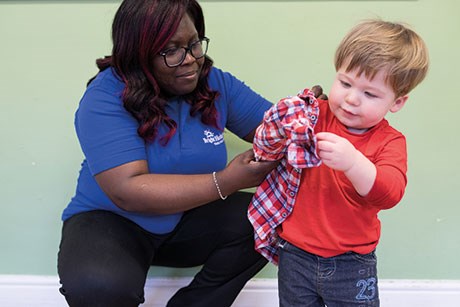
Key person and familiarity
Allied to the quality of a child’s experience is the adult who actually takes part in the care routine. For some time now, it has been best practice for this to be the child’s key person; the adult in the setting with whom the child has the closest bond. The key person also knows the child well. They can recognise frustration, playfulness, but also tiredness in a child. The key person is responsive to the child and knows what the child needs and enjoys.
The familiarity of repeatedly experiencing a thoughtful and positive care routine allows children to relax and also to become increasingly participative and so learn some elements of self-care. In addition, the opportunities for care routines to contribute towards language development are far greater when children have an existing bond. Some babies and toddlers will avoid eye contact and interaction or will respond only minimally if they are changed by someone they do not know.
In large group care settings, ensuring that it is only the key person who is responsible for care routines can be tricky logistically on account of things such as breaks. It is important, therefore, that a co-keyperson system is in place so that children are always supported by a person with whom they have a bond.
This is particularly essential for nappy changes. In some early years settings that take a Pikler approach, routines such as nappy changing are ‘choreographed’ so that when the key person is not available, the child is still getting a familiar routine.
Questions for reflection
Do children in your setting have access to their key person for care routines?
What happens when the key person is not available?
Do key persons share with parents the learning potential within care routines?
CASE STUDY: BRIGHT HORIZONS SCOTLAND
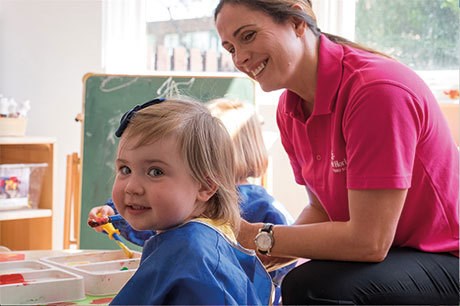
Bright Horizons Scotland has been reviewing and changing its practice at meal times for some time now, as Jane Logie, quality improvement manager, explains.
‘In 2012, we did some Pikler training and this has affected how we support our nurseries in Scotland. We really started with meal times in our baby and two-year-old rooms. As with many group settings, this used to be very task-orientated. Children would all eat together and this created quite stressful situations for both staff and children.
‘We began by removing the large tables and instead put smaller ones in so that no more than four children would eat at once. We also created a process around meal times so that the same adult would help the children get ready, sit with them and, once they had finished, support them with cleaning and then onto an activity.
‘At first there were concerns about the practicalities. How would children who were not eating straight away cope? When would staff be able to take their lunch break? These concerns were ironed out. Children who are not eating straight away are offered exciting and interesting activities, and staff have found that the more enjoyable and relaxing meal times are a good trade-off for sometimes having a slightly delayed break. The transformation has been amazing.
‘Children often choose when to go and eat. Staff are more tuned in to children’s cues and are thoughtful about which children need to eat, when. The opportunities for language around the table are much greater and there are more opportunities for children to be participative and mealtimes are seen as more of a learning experience.
‘In some settings, children are shown foods such as bananas whole before they are prepared. Staff also view meal times very differently. They are no longer events to rush through, but times to talk to and observe children. They are also times to encourage children to serve and be involved. Indeed, in a recent inspection, it was noted both in the baby and the toddler room how much independence and self- help skills children were showing.
‘If I were to advise any other nursery, I would point out how important it is to work with the room leaders, managers and, crucially, the chef. Everyone needs to be on board and to do this they need to understand the importance of the meal-time routine.’
MORE INFORMATION
‘All about…Pikler’ by Dorothy Marlen, ‘All about…sleep’ by Dr Natasha Kirkham, and ‘Sleepy time’ by Jackie Hardie are at: www.nurseryworld.co.uk


